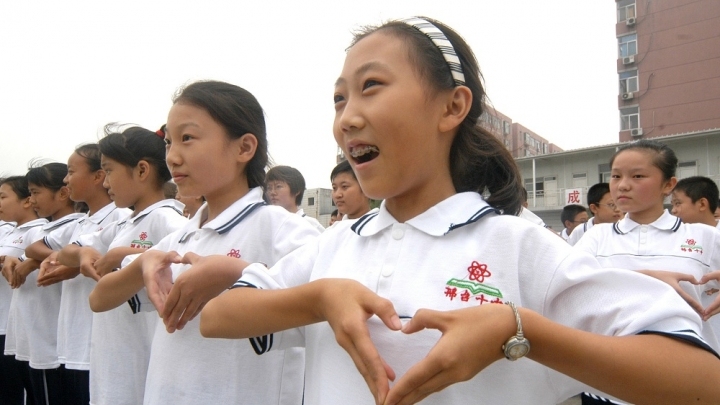China issues white paper on protecting disabled persons' rights in 70 years
China on Thursday issued a white paper on the country's efforts to protect rights and interests of persons with disabilities over the past 70 years.
![A man writes braille. [File photo: VCG]](https://p2crires.cri.cn/01dcri/images/zhycms_chinaplus/20190725/37387cf8-c5a8-45e2-8c22-feed1757a723.jpg?x-oss-process=image/resize,w_650)
A man writes braille. [File photo: VCG]
The white paper, titled "Equality, Participation and Sharing: 70 Years of Protecting the Rights and Interests of Persons with Disabilities in the PRC," was released by the State Council Information Office.
China now has around 85 million people with disabilities, according to the white paper.
Over the 70 years since the founding of the People's Republic of China (PRC) in 1949, the Communist Party of China and the Chinese government have always put the people first and provided care for the group with special difficulties, making them participants in, contributors to, and beneficiaries of the country's social and economic development, it said.
Zhang Haidi, a wheelchair-bound female writer and chairperson of the China Disabled Persons' Federation (CDPF), told a press conference that as a disabled person, she has witnessed and experienced real changes in the past decades.
Recalling that in the 1960s she was refused by most primary schools and had no means to obtain a wheelchair as a teenager. Zhang, now 64, lauded the development of the country's education and rehabilitation services for persons with disabilities.
The number of students in special education schools has grown significantly over the years. In 2018, 666,000 students with disabilities studied in these schools, an increase of 298,000 people, or 81 percent over 2013, according to the white paper.
Non-compulsory education for persons with disabilities has also made steady progress. In 2018, China had 133 secondary vocational schools or classes with an enrollment of 19,475 students with disabilities.
From 2012 to 2018, a total of 62,200 students with disabilities were enrolled in regular institutions of higher education.
"It's a good start, and we believe we will be able to send more children with disabilities to schools and even colleges," Zhang said.
The white paper noted that the development of the programs of persons with disabilities are still unbalanced and inadequate, and there is still a big gap between the lives these people lead and lives to which they aspire.
"China will continue to improve the mechanisms for ensuring their rights and interests -- eliminating discrimination, fully respecting and guaranteeing their human rights, improving their wellbeing, enhancing their ability to improve their situation, and ensuring that they are able to participate in the country's development process and share the ensuing gains as equals," it said.
IMPROVED LEGISLATION, EXPANDED NETWORK
By April 2018, more than 80 laws and 50 administrative regulations had been passed concerning the protection of the rights and interests of persons with disabilities, according to the document.
The CDPF, as a legitimate organization approved by the State Council, represents and safeguards the legitimate rights and interests of persons with disabilities. By 2018, a total of 42,000 disabled persons' federations had been set up across the nation.
Led by the CDPF, there are associations for persons with specific disabilities, such as visual, hearing and physical disabilities. By 2018, a total of 16,000 branches of these associations at provincial, prefectural (municipal) and county levels were in place.
MORE GOVERNMENT SPENDING
The programs of persons with disabilities have received increasing financial support in the past decades, said the white paper.
Disabled persons' federations across the nation spent 57.36 billion yuan (8.35 billion U.S. dollars) on their programs during the 11th Five-year Plan period (2006-2010), and the figure grew to 145.12 billion yuan during the 12th Five-year Plan period (2011-2015), an increase of 153 percent.
The investment was 41.67 billion yuan in 2016, the first year of the 13th Five-year Plan period (2016-2020), an increase of 24.15 billion, or 138 percent, compared with the first year (2011) during the 12th Five-year Plan period.
From 2013 to 2017, the fiscal allocations from all levels of the government for persons with disabilities added up to over 180 billion yuan, up 123 percent over the prior five years.
BETTER EMPLOYMENT, INSURANCE
In the past decade, the size and structure of employed persons with disabilities have remained stable, and the number has risen by 300,000 every year. In 2018, another 367,000 persons with certified disabilities were employed, according to the white paper.
By 2018, the employment figure of people with certified disabilities had reached 9.48 million.
The social security system for persons with disabilities has been steadily improved. By March 2018, over 9 million persons with disabilities had received urban or rural subsistence allowances.
By 2018, 25.61 million persons with disabilities had been covered by urban and rural social old-age insurance, and 10.24 million received pensions.
"They enjoy social assistance, welfare and insurance benefits according to regulations, and lead a higher-quality life with a greater sense of gain," the white paper said.

